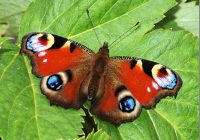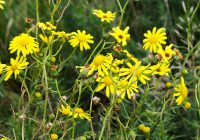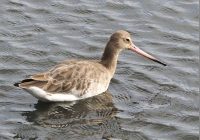Dr Phil Smith’s Wildlife Notes
October 2018
After the great drought of 1976, the heavens opened in September and October of that year, rapidly replenishing ground-waters, rivers and other wetlands. In complete contrast, following this summer’s comparable drought, September 2018 was dry, while October was even worse, with measurable rain on only five days, a named storm on 13th producing the only really wet day. Average October rainfall for Formby is 84mm (3.3 inches); we probably had half that. This is important because, apart from impacts on farmers, gardeners, water-supply, etc., so much of our special duneland wildlife depends on recharge of the water-table to produce seasonally flooded slacks. Instead of rising in October, the water level dropped by about 3cm at the Devil’s Hole measuring point.
The first half of the month was also warmer than usual, a temperature of 22o on 10th being the highest for October since 2011. This meant there were lots more insects around. Most people will have noticed the wasps. Extraordinary numbers were attracted to flowering Ivy, a distraction while I was searching for Ivy Bees. Pete Kinsella found several new sites in the Crosby area for this recent addition to our insect fauna and I joined him at Holden Road on 29th to photograph two of these stripy bees, with a host of different hoverflies. Pete tells me has recorded a remarkable 53 species of hoverflies so far this year. Most spectacular is the huge Hornet Hoverfly, also a recent arrival from the south. I was very pleased to catch up with a late one at the Ravenmeols Ivy on 17th. On that unseasonably warm and sunny day, I also saw Common Darters, a Hairy Sand-wasp and four Red Admirals. The following day, a Peacock butterfly and four Migrant Hawkers, including a mating pair, were flying at Sands Lake. Also late was a male Field Grasshopper at Ainsdale on 27th. Green and Hairy Shieldbugs were still sunning themselves on Ivy towards the end of the month.
Botanical recording continued into October, Patricia Lockwood and I listing 67 higher plants on the “Even Newer Green Beach”, the youngest section of embryo dune habitat north of the carpark at Ainsdale-on-Sea. This is a big increase on the 21 species we recorded there last year. One surprise was the nationally scarce Yellow Glasswort, more usually associated with the Ribble saltmarshes. Patricia also found the distinctive Narrow-leaved Ragwort on Freshfield Dune Heath Nature Reserveasa new plant for the dune coast. This African native has been spreading north through Britain since the turn of the millennium. The day I went to see it, there were also lots of red-and-white-spotted Fly Agarics in the dune heath woodland, perhaps the most easily recognised of the enormous variety of autumnal fungi. Less welcome was the large patch of Conolly’s or Bohemian Knotweed I noticed at the north end of the West Lancashire Golf Course, Hightown. This hybrid between Giant and Japanese Knotweed is even larger and more vigorous than its horribly invasive parents.
While at Hightown dunes, I was pleased to see that Gems in the Dunes volunteers had been busy creating about 10 bare-sand patches on south-facing slopes within the earlier fire-site. These will be ideal for basking Sand Lizards and many duneland insects. More essential management was undertaken by the volunteer “Buckthorn Bashers” who met at Sands Lake, Ainsdale, four times during the month to cut Sea Buckthorn north and west of the lake. Introduced here in the late 19th century, this invasive shrub is arguably the greatest threat to our sand-dune flora and fauna.
With autumn migration in full swing, birding is a popular activity in October. As usual, I missed out on several of the highlights, including Bearded Tits that turned up at both Marshside and Hightown in mid-month. These may well have been eruptive travellers from RSPB Leighton Moss in north Lancashire. Earlier, Marshside saw an enormous influx of Icelandic Pink-footed Geese, with about 8000 on 1st, increasing to a staggering 12,000 or so the following day. This species is doing well, the coordinated Lancashire count exceeding 94,000 in October 2017. Also increasing is another Iceland breeder, the Black-tailed Godwit, a long-billed wader that often feeds right in front of the Marshside hides. The cows grazing this RSPB reserve were accompanied by up to eight Cattle Egrets, a bird that was a rarity in Lancashire until quite recently. The adjacent Crossens saltmarsh was graced by a superb male Hen Harrier from about 20th, while other raptors during my visits included Merlin, Sparrowhawk Kestrel and up to six Marsh Harriers. While I was there, with extraordinary eyesight and a big telescope, Graham Clarkson picked out a Great Skua several miles away off Lytham. I could just about make it out. All these will no doubt feature in next year’s Lancashire Bird Report produced by the Lancashire & Cheshire Fauna Society. The 2017 report, just received, maintains the superb standard we have come to expect. Particularly fascinating is the ringing report which describes several marked Mediterranean Gulls seen in various parts of continental Europe as well as in Lancashire.




